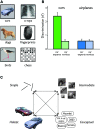Beyond perceptual expertise: revisiting the neural substrates of expert object recognition
- PMID: 24409134
- PMCID: PMC3873520
- DOI: 10.3389/fnhum.2013.00885
Beyond perceptual expertise: revisiting the neural substrates of expert object recognition
Abstract
Real-world expertise provides a valuable opportunity to understand how experience shapes human behavior and neural function. In the visual domain, the study of expert object recognition, such as in car enthusiasts or bird watchers, has produced a large, growing, and often-controversial literature. Here, we synthesize this literature, focusing primarily on results from functional brain imaging, and propose an interactive framework that incorporates the impact of high-level factors, such as attention and conceptual knowledge, in supporting expertise. This framework contrasts with the perceptual view of object expertise that has concentrated largely on stimulus-driven processing in visual cortex. One prominent version of this perceptual account has almost exclusively focused on the relation of expertise to face processing and, in terms of the neural substrates, has centered on face-selective cortical regions such as the Fusiform Face Area (FFA). We discuss the limitations of this face-centric approach as well as the more general perceptual view, and highlight that expert related activity is: (i) found throughout visual cortex, not just FFA, with a strong relationship between neural response and behavioral expertise even in the earliest stages of visual processing, (ii) found outside visual cortex in areas such as parietal and prefrontal cortices, and (iii) modulated by the attentional engagement of the observer suggesting that it is neither automatic nor driven solely by stimulus properties. These findings strongly support a framework in which object expertise emerges from extensive interactions within and between the visual system and other cognitive systems, resulting in widespread, distributed patterns of expertise-related activity across the entire cortex.
Keywords: expertise; fMRI; object recognition; review; visual cortex; visual perception.
Figures



Similar articles
-
What is special about expertise? Visual expertise reveals the interactive nature of real-world object recognition.Neuropsychologia. 2016 Mar;83:88-99. doi: 10.1016/j.neuropsychologia.2015.06.004. Epub 2015 Jun 18. Neuropsychologia. 2016. PMID: 26095002 Review.
-
High-resolution imaging of expertise reveals reliable object selectivity in the fusiform face area related to perceptual performance.Proc Natl Acad Sci U S A. 2012 Oct 16;109(42):17063-8. doi: 10.1073/pnas.1116333109. Epub 2012 Oct 1. Proc Natl Acad Sci U S A. 2012. PMID: 23027970 Free PMC article.
-
Distributed and interactive brain mechanisms during emotion face perception: evidence from functional neuroimaging.Neuropsychologia. 2007 Jan 7;45(1):174-94. doi: 10.1016/j.neuropsychologia.2006.06.003. Epub 2006 Jul 18. Neuropsychologia. 2007. PMID: 16854439 Review.
-
Cortical Thickness in Fusiform Face Area Predicts Face and Object Recognition Performance.J Cogn Neurosci. 2016 Feb;28(2):282-94. doi: 10.1162/jocn_a_00891. Epub 2015 Oct 6. J Cogn Neurosci. 2016. PMID: 26439272 Free PMC article.
-
Revisiting the role of the fusiform face area in visual expertise.Cereb Cortex. 2005 Aug;15(8):1234-42. doi: 10.1093/cercor/bhi006. Epub 2005 Jan 26. Cereb Cortex. 2005. PMID: 15677350
Cited by
-
Experience Shapes the Development of Neural Substrates of Face Processing in Human Ventral Temporal Cortex.Cereb Cortex. 2017 Feb 1;27(2):1229-1244. doi: 10.1093/cercor/bhv314. Cereb Cortex. 2017. PMID: 26683171 Free PMC article.
-
Perceptual expertise improves category detection in natural scenes.Psychon Bull Rev. 2016 Feb;23(1):172-9. doi: 10.3758/s13423-015-0872-x. Psychon Bull Rev. 2016. PMID: 26106059 Free PMC article.
-
The Effect of Art Expertise on Eye Fixation-Related Potentials During Aesthetic Judgment Task in Focal and Ambient Modes.Front Psychol. 2018 Oct 16;9:1972. doi: 10.3389/fpsyg.2018.01972. eCollection 2018. Front Psychol. 2018. PMID: 30459676 Free PMC article.
-
Does an Over-Connected Visual Cortex Undermine Efforts to Stay Sober After Treatment for Alcohol Use Disorder?Front Psychiatry. 2020 Dec 10;11:536706. doi: 10.3389/fpsyt.2020.536706. eCollection 2020. Front Psychiatry. 2020. PMID: 33362591 Free PMC article.
-
Quantifying two-dimensional and three-dimensional stereoscopic learning in anatomy using electroencephalography.NPJ Sci Learn. 2019 Jul 17;4:10. doi: 10.1038/s41539-019-0050-4. eCollection 2019. NPJ Sci Learn. 2019. PMID: 31341638 Free PMC article.
References
Publication types
LinkOut - more resources
Full Text Sources
Other Literature Sources

